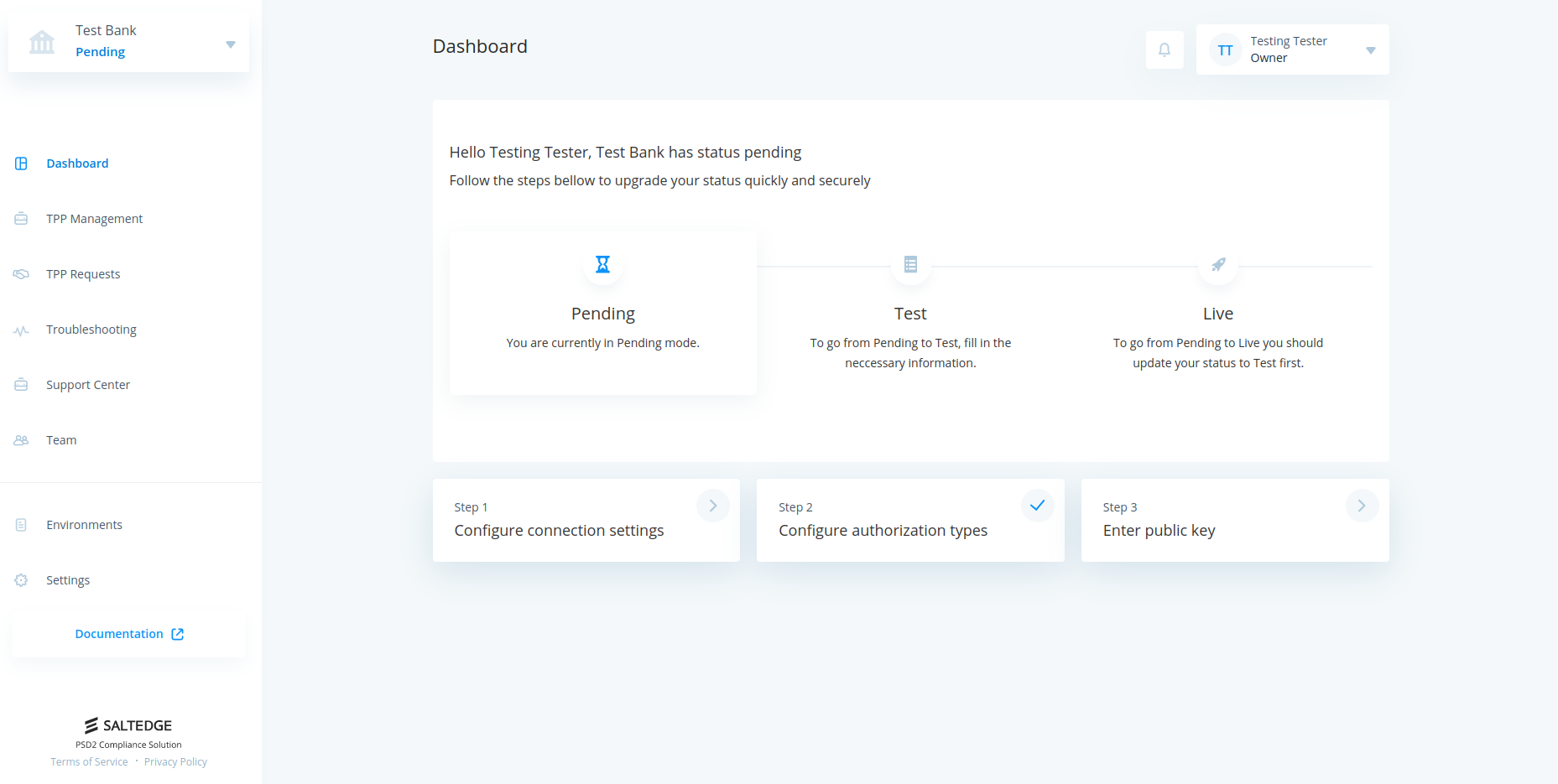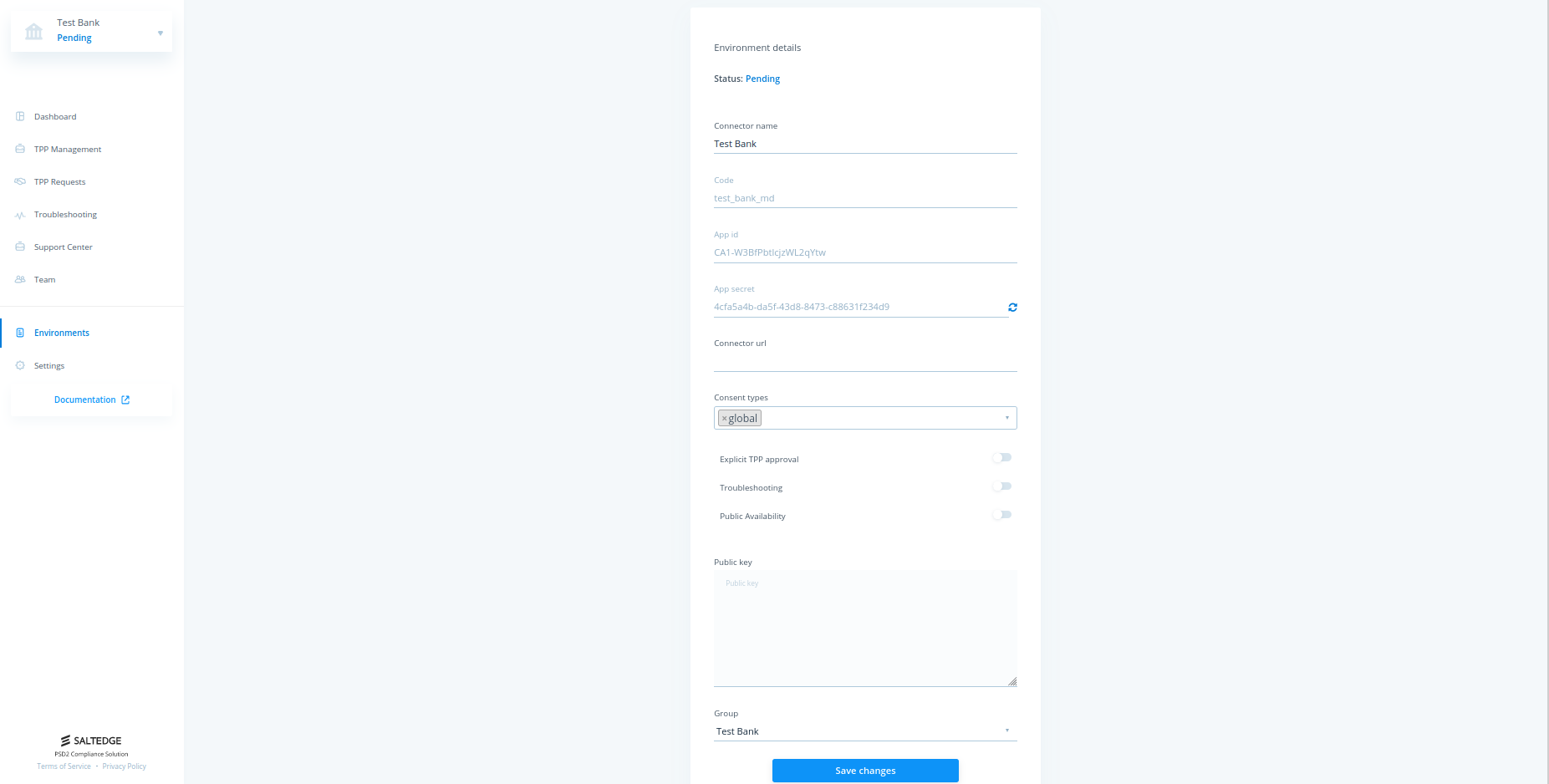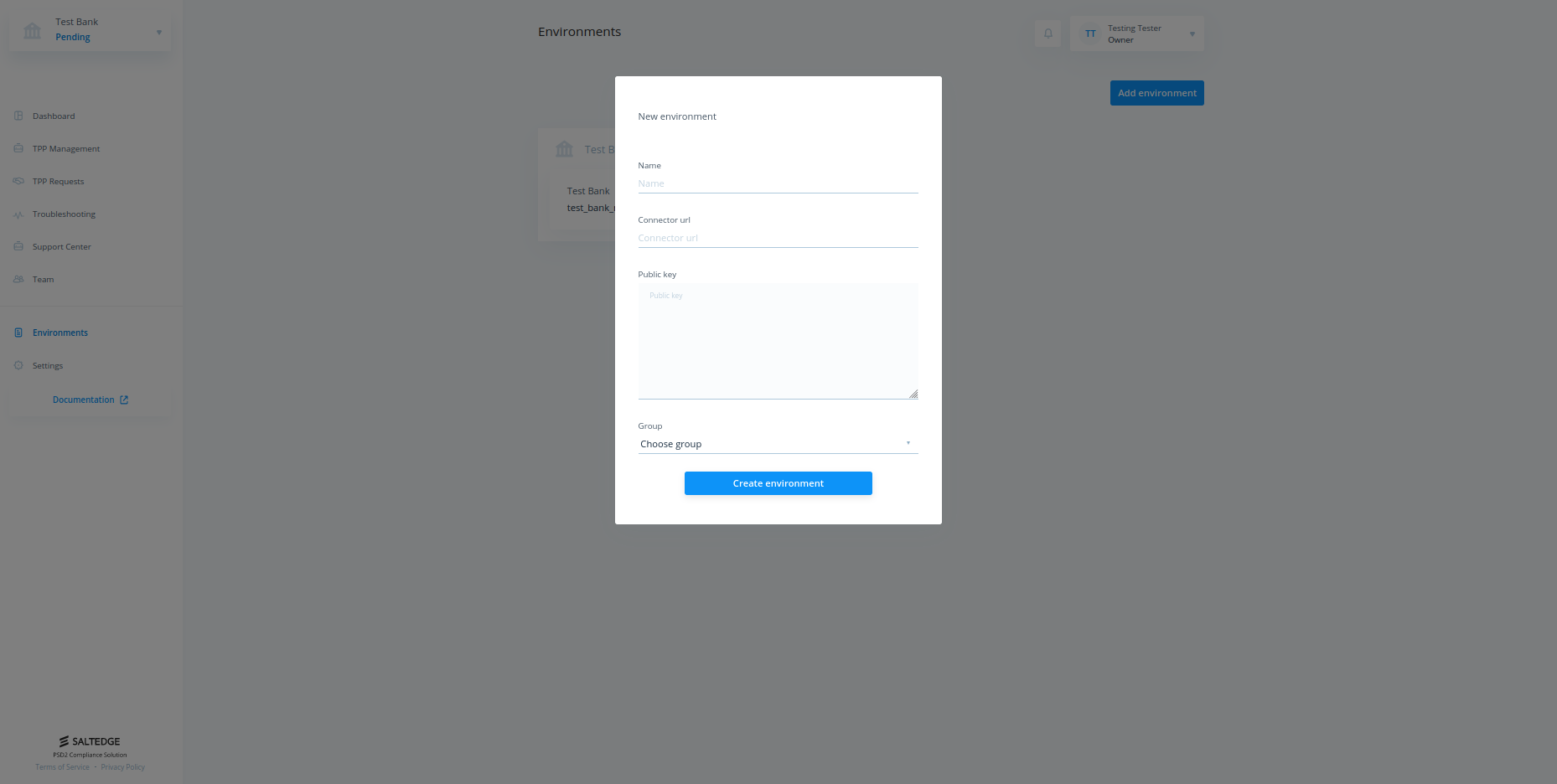Introduction
Salt Edge PSD2 ASPSP Docs represents a blend of Connector and Salt Edge Endpoints, which enable an ASPSP to provide Open Banking UK compatible API to potential Third Party Providers.
Connector Endpoints are responsible for handling requests sent by Salt Edge PSD2 Compliance SaaS. Through Connector Endpoints ASPSP implements handling of PSU authentication and fetching process of account information data.
Due to the asynchronous nature of PSU authentication API, Connector is required to communicate with Salt Edge PSD2 Compliance SaaS using Salt Edge Callback Endpoints. Salt Edge Endpoints are responsible for receiving callbacks related to the redirect page for PSU authentication as well as the current state of this process.
Changelog
| Timestamp | Change/note |
|---|---|
| 23 Dec 2021 |
The CBC-mode cipher encryption will be disabled on PSD2 APIs and the following cipher suites will no longer be supported since 3rd February 2022:
|
Definitions
| Term | Definition |
| API | Application Programming interface. A set of definitions, protocols, and tools that can be used to create applications, interact with other applications, and exchange data. |
| Provider | Represents the ASPSP. A bank or financial institution that offers payment accounts with online access. |
| ASPSP | Account Servicing Payment Service Provider. Provides and maintains a payment account for a payer as defined by the and, with customer consent, payments initiated by third party providers and/or make their customers’ account transaction data available to third party providers via their API endpoints. |
| TPP | Organisations or natural persons that use APIs developed to Standards to access customer’s accounts, in order to provide account information services and/or to initiate payments. Third Party Providers are either/both Payment Initiation Service Providers (PISPs) and/or Account Information Service Providers (AISPs). |
| PSU | Payment Service User. Natural or legal person making use of a payment service as a payee, payer or both. |
| AISP | Account Information Service Provider. Provides account information services as an online service with consolidated information on one or more payment accounts held by a payment service user with one or more payment service provider(s). |
| PISP | Payment Initiation Service Provider. Provides an online service to initiate a payment order at the request of the payment service user with respect to a payment account held at another payment service provider. |
| CBPII | Card Based Instrument Issuer. A Card Based Payment Instrument Issuer is a payment services provider that issues card-based payment instruments that can be used to initiate a payment transaction from a payment account held with another payment service provider. |
| SCA | Strong Customer Authentication. Authentication based on the use of two or more elements designed in such a way as to protect the confidentiality of the authentication data. |
| PSR | Payment Services Regulations 2017. The UK's implementation of PSD2, as amended or updated from time to time and including the associated Regulatory Technical Standards as developed by the EBA. |
| Session | Any activity that is forwarded by Salt Edge PSD2 Compliance on behalf of a Customer. |
| Consent | A range of rules on security, providing access to accounts, and enabling traceability and the mitigation of fraud risks. |
| Scopes | A set of permissions granted to a TPP application. |
| Authorization | The API will allow an ASPSP to implement OAuth2 as a support for the authorisation of the PSU towards the TPP for the payment initiation and/or account information service. In this case, the TPP will be the client, the PSU the resource owner and the ASPSP will be the resource server in the abstract OAuth2 model. |
| eIDAS | Electronic Identification, Authentication and trust Services. A set of standards for electronic identification and trust services for electronic transactions in the European Single Market. |
| OBSEAL | OBIE issued Electronic Seal Certificate. |
Minimal requirements
TLS
Salt Edge PSD2 Compliance Solution supports the following versions: TLSv1.2 and TLSv1.3.
Why does this matter?
Older TLS versions are vulnerable to security breaches with the wrong cipher suites. Be sure to upgrade your TLS version up to TLSv1.3.
What is TLS?
TLS stands for “Transport Layer Security.” It provides privacy and data integrity between two communicating applications. It is used to authenticate one or both applications, and protect the confidentiality and integrity of information that passes between them.
Registration and API keys
In order to start setting up the API keys, you will have to register into the ASPSP dashboard by following these steps:
- Go to the ASPSP dashboard registration page and provide your full name and email address.
- Confirm your email address, you should have received a confirmation instruction email.
- Set up a password, read and agree to the Terms of Service and Privacy Policy.
- Login into your account and link your account to Salt Edge Authenticator to keep it safe. The Authenticator can be download via:
- Provide more details about your business, such as: Bank name, legal name, email address, phone number and business address.
- Account has been created, however it is still in the pending stage.

In order to move from Pending status to Test status, please follow the steps below:
- Either click on Configure connection settings , or go to the Environments tab and click on your newly created environment. An environment is a set of configurations for a specific connector implementation. The configuration consists of:
- Connector name - the name displayed to the TPP before creating a connection.
- Code - unique identifier of connector in Salt Edge Compliance Service. Used by TPP to establish connection.
- App id - generated credentials that are required for sending requests from Connector Service to Salt Edge Compliance Service.
- App secret - generated credentials that are required for sending requests from Connector Service to Salt Edge Compliance Service. Can be generated indefinitely.
- Connector url - URL of connector service which implements Connector API.
- Public key - used by Salt Edge Compliance Service to verify JWT signature while validating requests from Connector Service.
- Fill in the Connector url and Public key fields in order to switch your account to Test mode.
- Please note: we strongly recommend enabling the Troubleshooting option during the development stage in order to access the Troubleshooting tab.

In order to create a new environment, it is required to fill only Name, Connector url and Public key.

Private and public keys
Since all the communication between Salt Edge Compliance and Connector happens via JWT payloads, a pair of private and public keys has to be generated. To generate the keys, please run the following commands in terminal:
| OS | Steps to reproduce |
|---|---|
| Linux/MacOS |
|
| Windows |
|
Save the “private.pem” file, and never share it with anyone. It should be present only on machines that will make requests to Salt Edge Compliance. Additionally, “public.pem” has to be uploaded to Salt Edge Compliance to the Public key label of the environment settings.
Once you’ve set up the environment and were switched to Test, please reach out to our representative at compliance-hub@saltedge.com in order to receive access to a Demo TPP interface for further development.
Using the API
Request verification using JWT
JSON Web Token (JWT) is an open standard (RFC 7519) that defines a way to securely transmit information. Salt Edge PSD2 Compliance API requires JWTs to authorize each API request. Implementing a standard that allows Providers and TPPs to securely transmit information provides greater protection of sensitive data and the entire Salt Edge PSD2 Compliance Solution.
Salt Edge PSD2 Compliance uses JWTs as a vehicle to send and receive signed requests to and from Connector. Connector is supposed to receive JWT signed requests from Salt Edge PSD2 Compliance on any of Connector Endpoints described in documentation and respond with a JSON. Connector is required to send a JWT signed request (RS256, RS384, RS512 alghorithm) on any of Salt Edge Endpoints described in documentation and receive an empty JSON with a HTTP status code as a response.
Salt Edge PSD2 Compliance will always send requests with a JWT signed by its private key. This allows Connector the ability to validate that the request form Salt Edge PSD2 Compliance has not been tampered with.
Example of decoded JWT header
{ "typ": "JWT", "alg": "RS256" }
Example of decoded JWT payload
{ "data": { "provider_code": "demobank", "scopes": [ "accounts", "transactions", "kyc", "payments", "funds_availability" ], "consent_period_days": 90, "credentials": { "required_key": "value" }, "redirect_url": "https://user.will.be/redirected/here" }, "exp": 1560162919 }
Salt Edge PSD2 Compliance public key
-----BEGIN PUBLIC KEY----- MIIBIjANBgkqhkiG9w0BAQEFAAOCAQ8AMIIBCgKCAQEAw+4UebzWIN9SNnFm9WBv rvH7CiVyuobh5i2V1bKH7floZSh71xbBnvZ2FsL2kleSJrOj03gh5zpdSxmR/Nj9 MyskswkFSO09bZo2C5ZWMsnFpH0oHRdBWl5hQWJFeuV9TVJkuSuO9XyrsdQMakVK eCRisxseCOo4wux1/tRl7smAlJXoOYF1QEkhoVB6K91JjmBi1DmI0J7W0RET9gsS EHzwVi12WrjCiEKplzN0u7b2i1ydiga2GKXZLxfBu0MfQVD/RI2eCEHmh3/sJPeV u4K5bbwD3hamIM1v4DaGBs7DtR6tk9Xtms79s/hEQWiFd0fjdW2rrp4vEnljobz5 GQIDAQAB -----END PUBLIC KEY-----
JWT Anatomy
A JWT is comprised of 3 sections of url base64 encoded strings of data separated by a period. The first 2 sections are JSON objects while the last section is a digital signature that has been url base64 encoded. The sections are as such:
- header - A small JSON object that specifies what type of algorithm was used to generate the digital signature. This section is denoted in the below example in red.
- payload - A JSON object that contains the data being sent from one party to another. This section is denoted in the below example in green.
- signature - A url base64 encoded hash value of the header and payload. This is used to verify the contents of the JWT have not been tampered with. Signatures are created with RS256 alghorithm, using a public/private key pair. The identity provider uses his private key to generate the signature, and the consumer of the JWT uses the requester public key to validate the signature. Since the public key, as opposed to the private key, doesn't need to be kept secured, most identity providers make it easily available for consumers to obtain and use (usually through a metadata URL).
Example of JWT:
eyJ0eXAiOiJKV1QiLCJhbGciOiJSUzI1NiJ9. eyJkYXRhIjp7InByb3ZpZGVyX2NvZGUiOiJkZW1vYmFuayIsInNjb3BlcyI6WyJhY2NvdW50cyIsInRyYW5zYWN0aW9ucyIsImt5YyIsInBheW1lbnRzIiwiZnVuZHNfYXZhaWxhYmlsaXR5Il0sImNvbnNlbnRfcGVyaW9kX2RheXMiOjkwLCJjcmVkZW50aWFscyI6eyJyZXF1aXJlZF9rZXkiOiJ2YWx1ZSJ9LCJyZWRpcmVjdF91cmwiOiJodHRwczovL3VzZXIud2lsbC5iZS9yZWRpcmVjdGVkL2hlcmUifSwiZXhwIjoxNTYwMTYyOTE5fQ. O6edlfyG_tuh_ZHJC05gua1g9ZjIBDLev7wCJdDwm2ovCFWRR3vTOHhDf87dCNT3to-xW84iiYpeGWTDEzBQNug7TcJAIQF69bXr-Jh2hyT2Szlq44aWut-Qxr_nlQ7nfXaOfC30FfiG7TFq-njVY4-Z4Ham8hpnXkMy5b6PlMGaSmN6L9-QccdxpkS0ocXG3s0wHYi3P6WSUuGZIfXKVBDtud7qMkKzTEEl9xqhWHQiXeHxiM9SugzvU5CYfQd1H0KFw-qEUGIhXQc1OdaZNOAljawMCe8xwyqe5mYGnfCX6Cf1mR9zrp9MAxBB1Tfz61Km0aAYXKaa8HkQcqLDgA
JWT libraries
In order to use JWT tokens, you'll need to have a token generator. You can generate JWT tokens by utilizing one of the many libraries available on the JWT website.
How to use JWT
All requests that are either forwarded by or originated on Salt Edge PSD2 Compliance will be signed using Salt Edge PSD2 Compliance private key (RS256 alghorithm) in the form of a JWT containing exp and data claims that can be verified using Salt Edge PSD2 Compliance public key.
- exp is an UTC timestamp in seconds, preferred value is current time plus 120 seconds.
- data may include the original_request parameters that were sent to Salt Edge PSD2 Compliance by TPP applications. This is done to ensure that no Man-in-the-Middle attacks have occurred during request life cycle and that no data was tampered on its way from TPP to Salt Edge PSD2 Compliance to Connector. In seldom cases along parameters encoded into JWT there will be regular HTTP parameters.
All Errors
During any request or flow originating either on TPP or Salt Edge PSD2 Compliance side, a number of errors may appear. In order to standardize errors while still giving some degree of freedom in explaining an error callback, parameters should include both error_class and error_message. Error message serves the purpose of communicating the issue to the Customer, whereas error class should be used by TPPs in order to be able to handle various scenarios.
Contents of the error_message are entirely up to the Provider, they may even be localized. However, values sent within error_class parameter should be from the standardized list. This list may and will be extended over time.
| Class | Code | Description |
|---|---|---|
| EncodingInvalid | 400 | Given data cannot be encoded on our side. Please use utf-8 encoding. |
| ScopesInvalid | 400 | Specified scopes don't match with the ones specified in Provider or OAuthApp. More info in error_message
|
| ConfigurationError | 400 | Missing configurations in dashboard. |
| PublicKeyInvalid | 400 | Given public key is not a public key. |
| RequestFormatInvalid | 400 | Request format is wrong. Details are stored in error_message
|
| ValueOutOfRange | 400 | One of specified values are out of range. |
| SessionClosed | 400 | Session specified in request is already closed and cannot be modified. |
| JWTDecodeError | 400 | Authorization Token header has wrong format. |
| JWTExpiredSignature | 400 | Authorization Token header has expired. |
| JWTVerificationError | 400 | Salt Edge PSD2 Compliance could not verify specified Authorization Token |
| JWTIncorrectAlgorithm | 400 | Authorization Token was encrypted with incorrect algorithm. Please use RSA256 algorithm for encrypting. |
| JWTClaimMissing | 400 | Authorization Token expiration is not provided. Please specify exp alongside data field. |
| TokenMissing | 400 | This request cannot be performed without Access_Token header. |
| AuthorizationMissing | 401 | Authorization header is missing. |
| TokenExpired | 401 | Token specified in request is expired and cannot be used. |
| TokenRevoked | 401 | Token specified in request is revoked and cannot be used anymore. |
| AuthTokenNotFound | 401 | Token specified in request does not exist or cannot be retrieved. |
| AuthorizationTypeNotFound | 401 | Authorization Type specified in request does not exist or cannot be retrieved. |
| WrongRequiredFields | 401 | Specified required fields were not provided. More info in error_message
|
| ClientNotFound | 401 | Client specified in request does not exist or cannot be retrieved. |
| SessionExpired | 401 | Found session is expired and cannot be processed anymore. |
| SessionFinalised | 403 | Session specified in request is already finalised and cannot be processed. |
| ResourceUnknown | 404 | The addressed resource is unknown relative to the TPP |
| TokenNotFound | 404 | Token specified in request does not exist or cannot be retrieved. |
| SessionNotFound | 404 | Session specified in request does not exist or cannot be retrieved. |
| AccountNotFound | 404 | Account specified in request does not exist or cannot be retrieved. |
| CustomerNotFound | 404 | PSU specified in request does not exist or cannot be retrieved. |
| ProviderNotFound | 404 | Provider specified in request does not exist or cannot be retrieved. |
| RouteNotFound | 404 | Wrong request URL. |
| FetchingError | 404 | There were some problems while fetching PSU's data. Please, retry later. |
| ClientDisabled | 406 | Cooperation with specified Client is impossible. |
| ProviderDisabled | 406 | Cooperation with specified Provider is impossible. |
| ActionNotAllowed | 406 | You're not allowed to perform this action. This might be a configuration problem or parameters incompatibility. |
| Deprecated | 410 | Specified resource has been deprecated and cannot be used anymore. |
| InternalServerError | 500 | Something went wrong on our side. You can report this behaviour, but most probably our developers have already started working on it. |
| InternalProviderError | 500 | Something went wrong on Provider(ASPSP) side. |